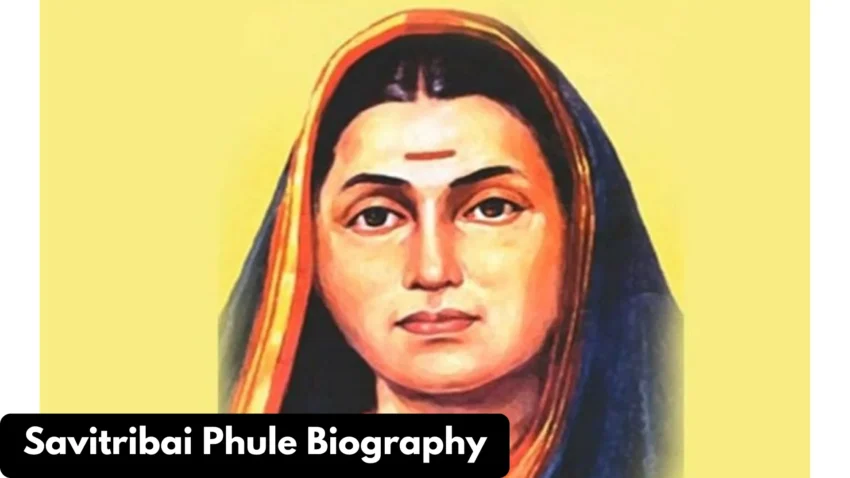Savitribai Phule (3 January 1831 – 10 March 1897) is celebrated as one of India’s earliest women educators and a fearless social reformer who opened doors to formal education for girls and marginalized communities during the 19th century.
Her efforts—tireless teaching, institution-building, writing, and social activism—helped shape the early movement for gender equality and social justice in colonial India.
Early life and background
Born in Naigaon (present-day Satara district, Maharashtra) in 1831, Savitribai belonged to the Mali community and was married very young to Jyotirao (Jotiba) Phule. Initially illiterate, she received her education under the guidance of her husband and later from teachers and normal-school training programs, which equipped her to become one of the first trained female teachers and headmistresses in India. Her transformation from an illiterate bride to a formally trained educator is central to understanding her later mission.
Partnership with Jyotirao Phule — education as a mission
Savitribai’s life and work were closely intertwined with Jyotirao Phule’s reformist vision. Together they established the first girls’ school in Pune (at Bhidewada) in January 1848 — a radical act at a time when female education was discouraged by orthodox segments of society. Beginning with a small group of girls, the Phules expanded their work despite severe social hostility. By 1851 they were running multiple schools and by later years had opened several institutions to educate girls and lower-caste children.
Teaching, curriculum and reach
Savitribai’s classrooms did more than teach basic literacy: the syllabus included arithmetic, reading, and practical subjects intended to empower girls intellectually and socially. She worked with allies like Fatima Sheikh and Sagunabai Kshirsagar to broaden the reach of schooling to girls from different castes and communities. Contemporary accounts detail that the Phules were running several schools in Pune and surrounding areas, often facing threats, verbal abuse, and even physical attacks from those opposed to their work.
Social reform beyond the classroom
Education for Savitribai was inseparable from social reform. Alongside Jyotirao she supported the Satya Shodhak (Satyashodhak) movement that challenged caste hierarchies and Brahminical domination. The Phules also worked on initiatives to stop infanticide and to provide support to child widows and other vulnerable groups. Savitribai’s poetry and short works reflect a humanitarian and feminist outlook that critiqued both gender and caste oppression.
Literary contributions
Savitribai was also a poet and writer. Her collections include Kavya Phule (1854) and later works that urged marginalized people to seek education and dignity. Her writings are an important record of the social conscience of a woman who used both language and action to push for reform.
Challenges, resistance and courage
The Phules’ work drew fierce opposition from conservative sections. Savitribai often endured public humiliation: stones and dung were thrown at her while she walked to school, insults were common, and social ostracism was a constant threat. Yet she persisted—opening schools, training teachers, and reaching out to underprivileged families despite the risks.
Final years and sacrifice
In 1897, when a bubonic plague epidemic struck areas near Pune, Savitribai and her adopted son Yashwant set up care facilities to help infected families. In a widely recounted act of compassion, she carried a plague-affected child to medical help and, while doing so, contracted the disease herself. Savitribai died on 10 March 1897 while serving the sick—an act that cemented her legacy as both educator and humanitarian.
Legacy and recognition
Savitribai Phule’s legacy continues across modern India: institutions, awards, and commemorations bear her name. The University of Pune was renamed Savitribai Phule Pune University in her honor, and her birth anniversary (3 January) is celebrated in Maharashtra as Balika Din (Girl Child Day). Educational scholarships and government programs also use her name to underscore access to schooling for girls and disadvantaged communities. Her image and story endure in textbooks, plays, films, and public memorials.
Frequently Asked Questions
Who was Savitribai Phule?
Savitribai Phule was an Indian educator, poet, and social reformer born on 3 January 1831. She is celebrated as one of India’s first female teachers and a pioneer of women’s education. :contentReference[oaicite:26]{index=26}
When and where did she start the first girls’ school?
She and Jyotirao Phule started India’s first girls’ school at Bhidewada in Pune in January 1848.
What were her main contributions beyond teaching?
She fought caste discrimination, promoted women’s rights, worked on anti-infanticide efforts, wrote poetry, and cared for plague victims—ultimately sacrificing her life in service.
Did she write any books or poems?
Yes—her works include Kavya Phule (1854) and later writings advocating education and reform.
How is she remembered today?
Through institutions named for her, commemorative days like Balika Din, postal stamps, and public memorials.
Conclusion
Savitribai Phule’s life story remains a powerful reminder that education and empathy can transform societies. Her courage in the face of hostility, her innovations in teaching, and her selfless service in times of crisis make her an enduring role model for educators and activists. Honoring her legacy means continuing to fight for equal access to education and dignity for every child.
